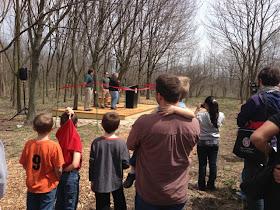On Saturday, I led an activity about the natural connections to
The Hunger Games
at Woodlawn Nature Center in Elkhart. I started reading the books several years ago before they were popular and immediately saw the natural applications and opportunities to practice skills and such.
Beth Cauffman pulled together several resources such as books on survival skills, wild edibles, and more.
We started by making nature journals to record what we did throughout the morning, including prompts and additional resources on the topic.
Allison McLean from
Elkhart Public Libraries helped us with a Hunger Games Jeopardy Game.
Fred Flury talked about tracking wild animals and signs to look for while out on the trail.
We headed out for a hike, looking at signs of animals (found several tracks!) and different plants in the forest. We found an old woodchuck den, dreys, places for shelter and food, and more.
This
bloodroot is pretty fascinating. Besides the pretty flower, the liquid inside is red, hence the name. It has been used as an insect repellant and for dyes in the past. Among the other plants, we had to find dandelions and garlic mustard as we were eating those later!
Later we played a game to get to know more wild edibles and medicinal plants that were mentioned in The Hunger Games and others that are native to our area.
We camouflaged orange pieces of paper, like Katniss camouflaged her backpack so that it wouldn't stick out as easily.
It was interesting to watch everyone use different technique, even going as far as to disturb other areas nearby to throw us off track once we tried to find them.
We talked about different things animals do for camouflage and how it helps protect them, as well as looked at different examples and specimens of this in action.
We played another game to simulate how camouflage is advantageous to the animals. The items that stuck out the most were found first!
We had the chance to try our hands at archery.
And had some treats . . . girl on fire cupcakes, mint tea with local honey, dandelion tea with maple syrup . . .
Cinnamon bread (like Peeta threw Katniss), goatcheese and basil (Prim gave to Katniss on reaping day), and a dandelion salad with berries and nuts. The dressing was very simple but delicious. 1/3 cup each of olive oil, balsamic vinegar, and maple syrup (which we made at home!).
Delicious! It was fun pulling together elements from the book with nature in our own back yards!
We also had a great discussion at the Nature Nook book group earlier in the week, mentioning how overarching themes talk about sustainability, local foods, foraging, and more! Of course, there are many more resources, quotes, and applications, but here are a few topics to note:
Birds--there are two fictional birds in the story, the
jabberjay and the
Mockingjay. The Mockingjay is used for communication and as a symbol of hope in the book.
Wild Edibles--The main character is named Katniss. Her father once told her, "As long as you can find yourself, you'll never starve." Possibilities include, dandelions, cattails, and Katniss, wild strawberries, raspberries, etc.
Here is a website that discusses wild edibles in the book:
Here is one video that talks about some wild edibles in the movie/book:
Video about where Katniss got her name:
Primitive Fire Making Skills--To survive in the arena, a fire is needed at times to keep warm and to cook game.
Tracking -- Katniss uses nature and tracking skills to hunt for food to sell in town and to feed her family. These are skills she learned from spending time with her father in nature. Small game hunting is part of the story, including rabbits, squirrels, etc.
Animals in the book--squirrels, rabbits, birds, deer, predators, etc.
Archery-- Katniss's father made her bow and arrows. She keeps this wrapped in leather and hidden in a log in the woods as they are banned in the community.
Nature Journals--Katniss and her father kept a nature journal of wild edibles and medicinal plants that were typical of their area.
Medicinal Herbs--Medical care is limited in the poorer areas of the book. Katniss's mother knows about medicinal plants and people often bring people to the home for care when the mother is doing well in life.
Shelters--Katniss often straps herself to a tree in a sleeping bag to stay safe and sleep at night, though others are able to build more temporary shelters on land. Knowing how to build a shelter with natural elements is a great skill in any survival situation.
Insects--There is a fictitious insect called a Trackerjacker in the book. This could be used to introduce people to similar insects in the area and myths/facts about these.
Camouflage--A main character, Peeta, uses his cake decorating skills to camouflage himself with natural elements/materials in the arena when he is wounded. This saves his life and allows him to remain hidden. This could be extended to camouflage in nature.
Survival skills/gear/packs--Some characters in the book are able to procure basic survival items in the arena. Having and knowing how to use appropriate items in an emergency pack can be critical to survival.
Coal--Coal mining is the main type of work in Katniss's area. Coal itself could be a topic, but then broader topics of rocks, mining, etc. could be touched on. We also looked at the different regions and natural elements they have.




































































